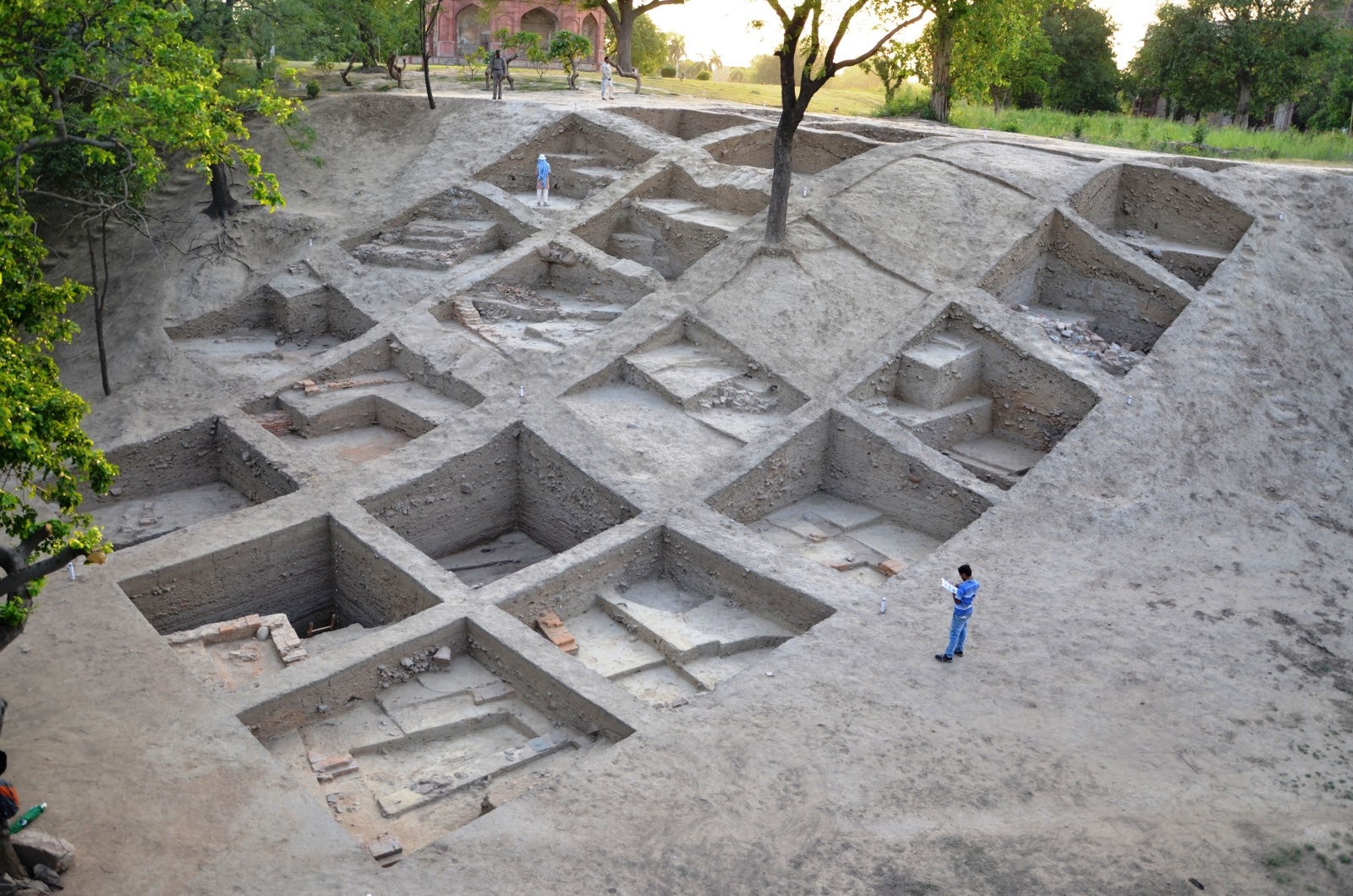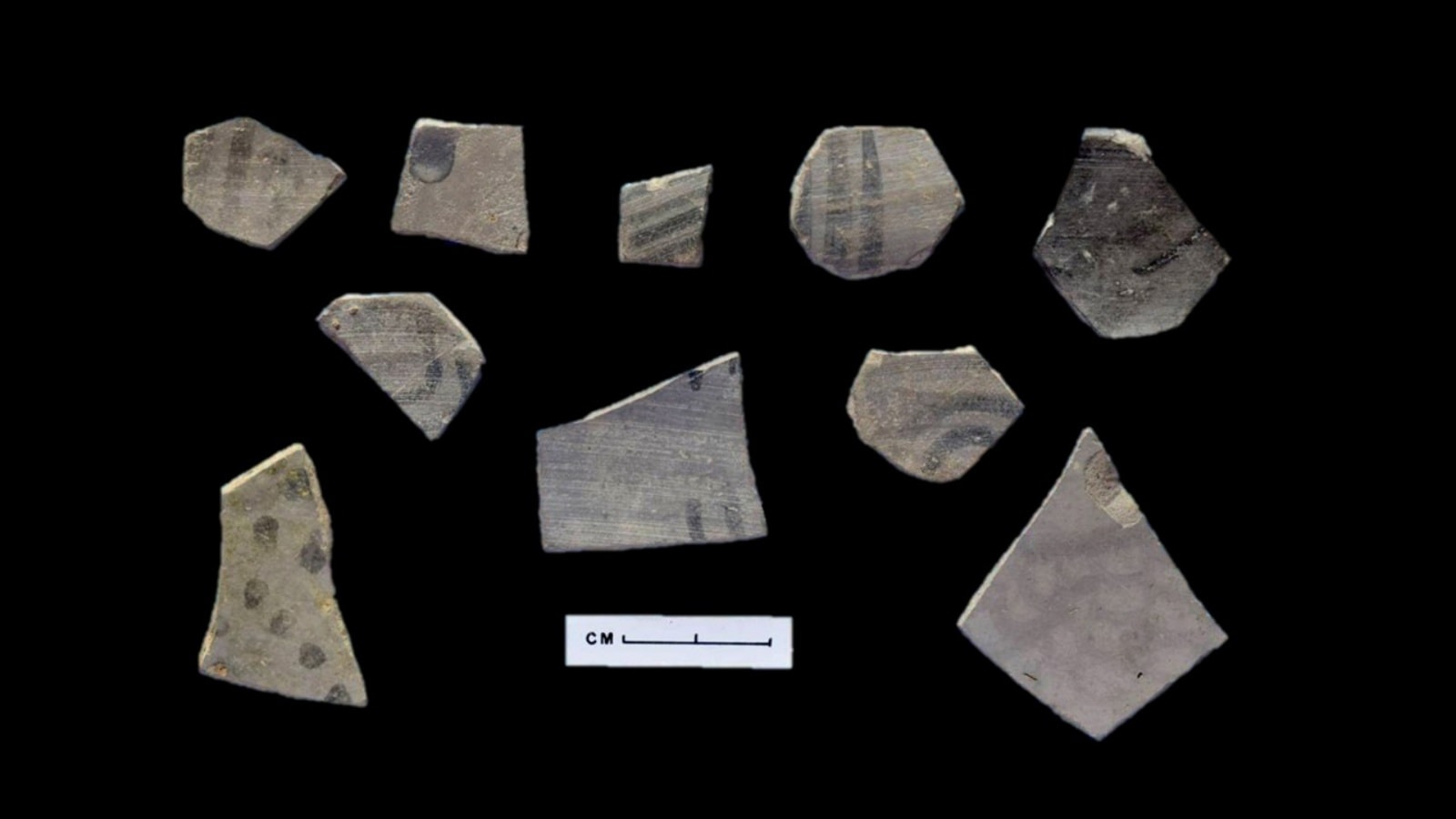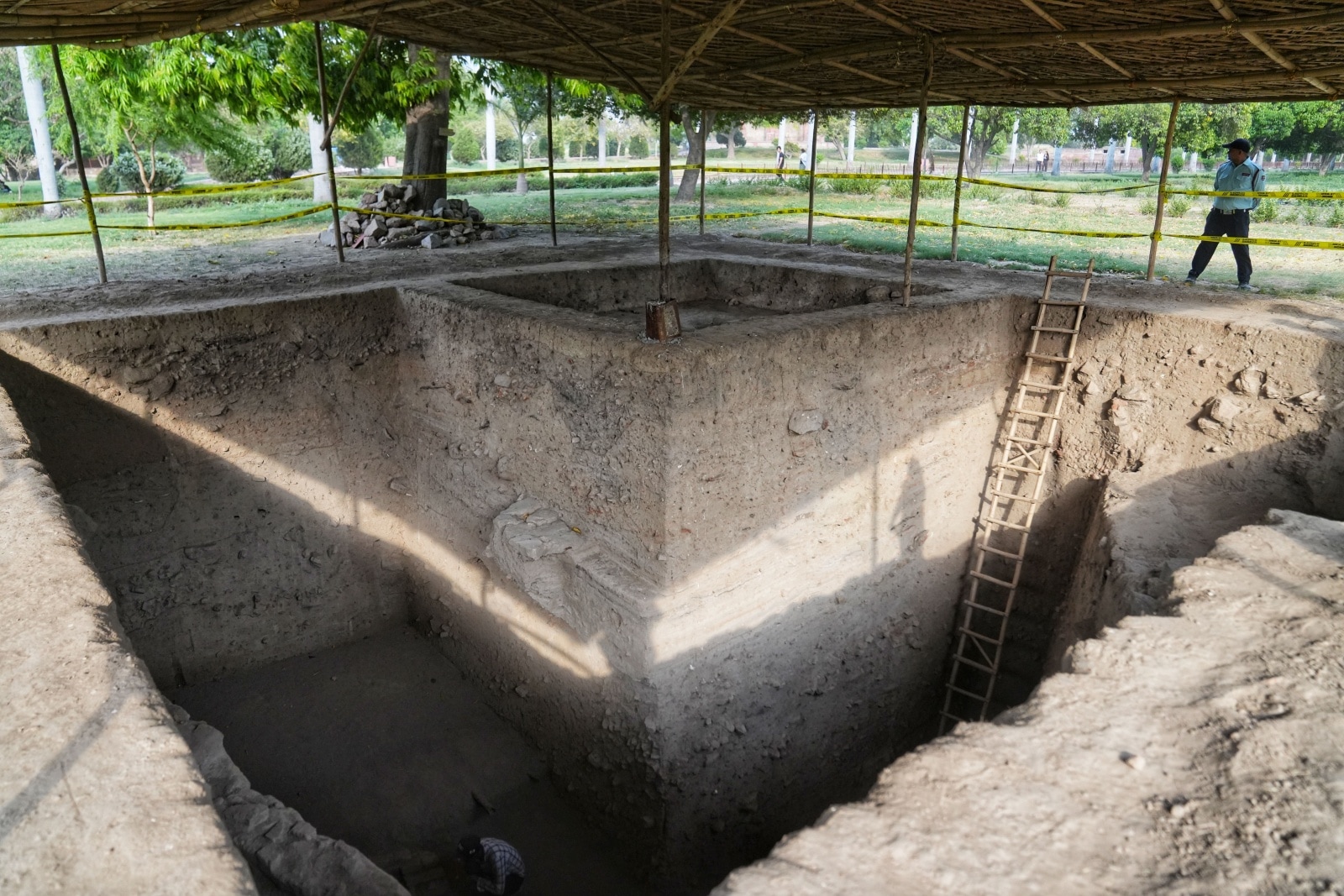On March 31, at a function to mark the handing over of the Purana Qila to the Dalmia Group’s Sabhyata Foundation, under the Ministry of Tourism’s ‘Adopt a Heritage’ scheme, was an hour-long depiction of the Mahabharata. Also on display were findings from past ASI excavations at the site – pottery sherds, coins and terracotta figurines.
Ajay Verma, CEO heritage and events of the Sabhyata Foundation, later told The Indian Express, “We have a vision for every monument we adopt. For Purana Qila, it is Indraprastha and the Mahabharata. All our tourist events, museums, interpretation centre and heritage walks at the site will be centred around the Mahabharata. We need to build the right narrative of the Purana Qila. Yes, Humayun built the fort, but the Pandavas had a huge influence on the fort and so the focus will be on them. We have scientific and archaeological evidence to build the right narrative.”
With the seventh round of excavations by the Archaeological Survey of India (ASI) – the most in the Delhi-National Capital Region – set to begin at the Purana Qila in a few months, a new layer of history is being uncovered at the 16th century fort built by the Mughal emperor Humayun. The goal: finding evidence to establish the fort’s link to the Mahabharata.
It is believed that the site of the fort was originally the city of Indraprastha, the capital of the Pandava brothers in the Mahabharata.
After years of digging, in 2014, a ‘crucial’ find
Displaying small bits of grey pottery, neatly rolled up inside a piece of soft white cotton cloth and padded with more layers of cotton, Vasant Swarnkar, director of the excavation at Purana Qila, says, “For you, this might just be some tiny things; for us, this is a most valuable finding.”
 View of the site excavated in 2014 and 2017 (Archaeological Survey of India)
View of the site excavated in 2014 and 2017 (Archaeological Survey of India)
The “valuable” Painted Grey Ware pottery sherds that sat in Swarnkar’s cupped palms are what the ASI hopes will be the key to a question that has baffled scholars, archaeologists and politicians alike – is Purana Qila the site of the city of Indraprastha?
While the quest to find archaeological evidence of the Mahabharata at the Purana Qila goes back to the years immediately following Independence – it was in 1954 that ASI archaeologist B B Lal (best known for his excavation at Ayodhya) first dug up the site – it was only in 2014 that the ASI “struck gold”, finding the PGW sherds they were looking for.
Talking of their find, Satarupa Bal, Assistant Archaeologist at the excavation site, says that in July 2014, the ASI was about to wrap up another disappointing round of excavations, the fourth, at the fort – like earlier rounds, this time, too, they had failed to find the PGW sherds.
“Right before closing down for the season, we decided to make one last attempt in a small trench… just in case. And we got lucky! It was like finding gold,” she exclaims. Right below a layer of compact yellow fluvial deposit was a collection of PGW.
Since then, the ASI has conducted two more rounds of excavations at the same site and is set to begin what Swarnkar says could be the “final” dig at Purana Qila. “Our objective is to settle the chronology of Purana Qila and find what its earliest historical phase is,” he says. “Was this site inhabited during the period of the Mahabharata?” This, Swarnkar says, is the key question behind the multiple excavations at the site.
What connects PGW to Mahabharata?
Until the 2014 find, PGW had eluded archaeologists at the Purana Qila. Now that they have found the sherds, the question is, would that confirm that the fort is indeed situated at the site of Indraprastha?
Painted Grey Ware or PGW is a fine, smooth, grey coloured pottery that’s produced by sophisticated firing techniques. They contain mostly geometric patterns in black or deep chocolate brown and usually occur in shapes such as open-mouthed bowls and dishes. Mostly found in the Indo-Gangetic divide, the Sutlej Basin and the Upper Ganga plains, PGW is dated between approximately 1100 BCE and 500/400 BCE – the timeframe that matches some of the wide estimates of when the Mahabharata was composed. While some scholars suggest the epic was written between 400 BCE and 400 CE, there are others who say it was written somewhere between the mid 2 BCE and 1 CE.
What links this specific type of pottery to the Mahabharata? ASI’s Swarnkar explains that in each of the other Mahabharata-related sites excavated by Lal, such as Hastinapur, Tilpat and Kurukshetra, PGW formed the lowest cultural deposit. So its presence at Purana Qila is confirmation of its Mahabharata connection, he believes.
 Painted Grey Ware sherds discovered by Swarnkar and his team in 2017. (Archaeological Survey of India)
Painted Grey Ware sherds discovered by Swarnkar and his team in 2017. (Archaeological Survey of India)
“With this excavation, we have found PGW and can claim with certainty that the history of Delhi can be traced back to 1200 BCE. It was well established by B B Lal that PGW is associated with the Mahabharata period, so now we can say that some activities of the Mahabharata period happened in this site. The Purana Qila excavation also proves that there has been continuous habitation in Delhi from 1200 BCE till today.
It’s a connection that many archaeologists find tenuous.
“The only logic of connecting the Mahabharata sites to PGW is that they were found in these other sites that feature in the epic. But then, that’s how most things are settled in history,” says archaeologist R S Bisht, who retired as Joint Director General of the ASI and is best known for leading excavations at multiple Indus Valley Civilisation sites.
The current Director General of ASI, Y S Rawat, too, is unsure of the connection between PGW and the Mahabharata. “It is hard to connect PGW with Mahabharata because we don’t even know when the events in the Mahabharata actually happened,” he says, noting further that in many of the sites excavated by Lal, cultural levels older than PGW have been found. As an archaeologist, I will not say that this is a Mahabharata site,” Rawat adds.
Historian Upinder Singh explains that the presence of PGW in sites related to the story in the Mahabharata simply suggests that these sites were “inhabited from about 1000 BCE onwards and that people who lived there shared a similar material culture”.
She goes on to underline that PGW has also been found at many sites that are not connected with the Mahabharata story. “For instance, in and around Delhi itself, PGW has been reported from many places such as Salimgarh, Majnu-ka-Tila, Bhorgarh, Mandoli, Kharkhari Nahar, Jhatikra, Gordon Highlanders’ Column near Badli ki Sarai, Bankner and Chhansa in Delhi, besides Sihi (Gurgaon), Bisrakh (Greater Noida), Loni (Ghaziabad) and Bhopani (Faridabad),” she says, before adding, “The occurrence of PGW in itself does not necessarily mean that a site is connected with the Mahabharata story. It means that these are among many ancient, roughly contemporaneous settlements, based on a broad similarity of material culture.”
Earlier attempts at finding PGW at Purana Qila
Historian Upinder Singh says there has always been speculation, going back to at least the 16th century, that associated the ancient capital of the Pandavas with the Purana Qila. She points to the work of Abul Fazl, the grand vizier of the Mughal Empire, who in his 16th century work ‘Ain-i-Akbari’ “gives a synopsis of the Mahabharata events and says that Delhi was first called Indrapat and that Humayun restored this citadel and named it Dinpanah”. Further, till the end of the 19th century, a village called Indrapat was located within the walls of the Purana Qila.
The first person to undertake a proper scientific enquiry into the archaeological proof of the Mahabharata in the Purana Qila was archaeologist Lal.
In ‘Indraprastha: The earliest Delhi going back to the Mahabharata times’, his book that was published a year before he died in September 2022, Lal wrote, “A very important point to note is that all Mahabharata sites, luckily, continue to bear the same names even today as they did in antiquity.”
 Site of the excavation carried out in 2023 and open to public currenty. ( Express photo by Abhinav Saha)
Site of the excavation carried out in 2023 and open to public currenty. ( Express photo by Abhinav Saha)
For instance, Hastinapur in present-day Uttar Pradesh is believed to have been the capital of the Kauravas, Mathura the birthplace of Krishna, and Kurukshetra in Haryana the site of the epic battle between the Pandavas and Kauravas. Only Indraprastha, the city founded by Yudhishthira and his brothers, got a new name, confounding history hunters. Most, however, believed that the city in the epic existed within the confines of modern-day Delhi.
Consequently, in 1954, Lal dug up a small trench in the southernmost part of the Purana Qila site. The results threw up evidence of Kushan (first century BCE to third century CE), Sunga (2nd century BCE to 1st century BCE) and Northern Black Polished Ware (3rd century BCE to 2nd century BCE) periods. The excavation also threw up a few sherds of Painted Grey Ware, which Lal claimed was “typical of the Mahabharata times” and evidence that the site could have experienced human settlement since as early as 1000 BCE.
However, the few PGW sherds that Lal found in Purana Qila came from an unstratified context. In other words, they did not come from a specific layer or period of human activity.
In 1969-70 and yet again in 1971-72, the ASI team led by Lal undertook more rounds of excavations at Purana Qila in the south-eastern part of the fort, a little to the north of the previous site. Both these excavations failed to find PGW remains. “Purana Qila was the only Mahabharata related site where PGW remains could not be found,” explains Swarnkar.
Forty years after Lal’s final dig at the fort, in 2013, Swarnkar, who was then posted in the Delhi Circle of the ASI as the superintendent archaeologist, decided to dig once again into the mystery of the Purana Qila.
Swarnkar explains that the entire mound identified as Indraprastha extended way beyond the frontiers of Purana Qila, and includes what is today the Delhi zoo, Humayun’s tomb and Sunder Nursery. “From these other areas also we have sporadically found some sherds of PGW,” says Swarnkar.
 Site of Purana Qila on the map of Delhi. (Edited by Angshuman Maity)
Site of Purana Qila on the map of Delhi. (Edited by Angshuman Maity)
For the sake of the excavation, though, he chose to limit the site to the south east corner of the Purana Qila. After that first breakthrough in 2014 – when the team found some PGW sherds – it was in the next round of excavations, in 2017, Swarnkar says, that the ASI was able to establish a layer of PGW findings.
The search, however, did not end. The PGW sherds, says Swarnkar, could not be carbon-dated since it was very close to the groundwater level. In order to confirm their findings, the ASI team took up yet another round of excavation in 2022 that ended in September 2023. This time, a different site was chosen, one that is close to the centre of the Purana Qila, near the Kunti Temple. Here, the team has already dug up around 6.5 metres and have so far reached the period between the Maurya and the Kushana dynasties.
With another round of digging, scheduled to begin later this year, the ASI team hopes to reach the level of PGW that will confirm that the fort is indeed the “historic site” of Mahabharata’s Indraprastha.







